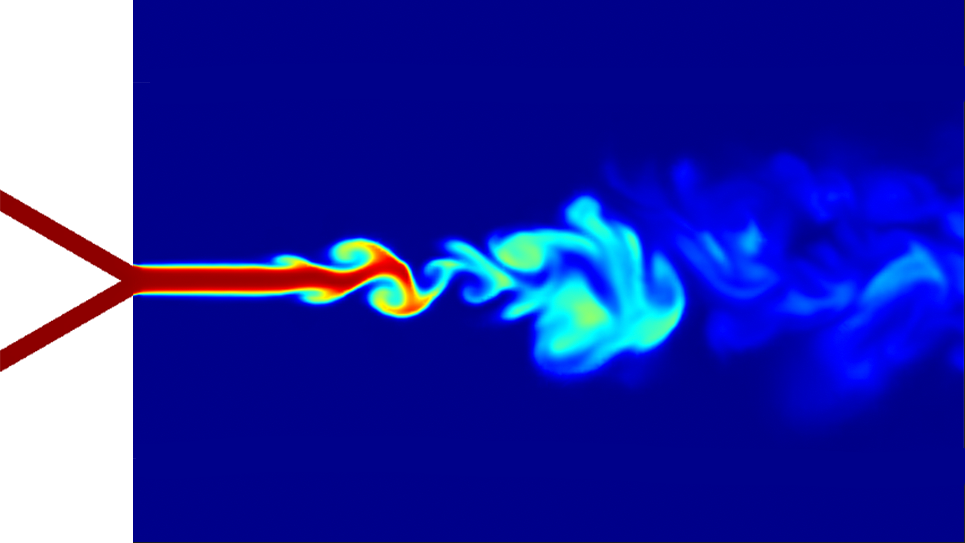
Computational fluid dynamics simulation of the melt-blowing process as modeled at Argonne. (Image: Argonne National Laboratory)
With support from DOE's HPC4EI program, Argonne and 3M researchers are leveraging ALCF computing resources and AI to improve the energy efficiency of a manufacturing process used to produce melt-blown nonwoven materials.
Melt-blown nonwoven materials form the basis of a range of filters, fabrics and insulation that includes critical items, such as N95 masks. Worldwide, manufacturers produce more than 300,000 tons of melt-blown nonwoven materials every year.
To minimize the energy footprint of the process, researchers from 3M and the U.S. Department of Energy’s (DOE) Argonne National Laboratory are leveraging Argonne Leadership Computing Facility (ALCF) resources to model and optimize the production of melt-blown nonwoven materials. The ALCF is a DOE Office of Science user facility at Argonne.
The researchers are aiming for an overall energy reduction of 20 percent.
The research is supported by DOE’s High Performance Computing for Energy Innovation (HPC4EI) program, which grants U.S. manufacturers access to DOE supercomputing resources and expertise. The program enables companies to tackle complex energy-efficiency challenges they would be unable or ill-equipped to address on their own.
The Argonne-3M project combines simulations, data analysis, and an artificial intelligence method called machine learning (ML) to reduce the energy consumed in the melt-blowing production process, without compromising material quality.
“Laboratory experiments are often very time consuming when considering equipment modification and changeover, which can take several days. Process temperature changes can also take several hours, drastically reducing the number of useful samples that can be performed in a day,” said Alex Flage, Senior Process Development Engineer at 3M. “The active ML approaches enabled by ALCF resources have allowed the team to accelerate development by utilizing known data and building models that predict outcomes without further experimentation.”
The initial model for the melt-blowing process was developed through a series of simulation runs performed on the ALCF’s Theta supercomputer with the computational fluid dynamics (CFD) software OpenFOAM. The researchers then scaled up the code using the CONVERGE CFD application.
For the models to closely match the company’s melt-blowing process, 3M first performs experiments to establish a process map for a particular production setup. The process map must identify which combinations of processing choices yield acceptable non-woven materials. This stage is crucial for generalizing the process maps to other production setups and source polymers.
“Our optimization approach combines ML for simulation parameter selection with high-fidelity fluid dynamics simulations for modeling the process and nozzle geometry,” Ben Blaiszik, a researcher at Argonne and the University of Chicago. “While we’re still working to identify and validate optimal process conditions in 3M facilities, we have successfully established a quantitative metric that should enable us to determine optimal parameters for this critically important industrial process through further simulations.”
Once the simulations reproduce a 3M experimental process map with sufficient accuracy, they can be used to optimize processing choices for a given polymer. The researchers will then employ ML techniques to determine preferred processing parameters by simulating different configurations of settings, like air pressure and temperature, and various geometric parameters, like the angle of the nozzle or the diameter of the nozzle opening. Learning from the simulations already generated, the ML algorithm suggests successive simulations with parameter settings iteratively refined to minimize energy consumption.
While ML methods have thus far been used to refine and select successive experiments, the researchers intend to investigate the use of recurrent neural networks and physics-informed neural networks for the prediction of fluid flow patterns in order to determine key metrics from comparatively brief simulation times.
The research team aims to perform simulations that hew more closely to the experimental process, made increasingly realistic by varying geometric parameters, such as polymer tip location in relation to the internal dye air knives.
After simulation and validation, the next step is implementation.
“Given the size of this market space,” Flage said, “a melt-blowing process that reduces energy expenditures by 20 percent has the potential to carry global impacts.”
==========
The Argonne Leadership Computing Facility provides supercomputing capabilities to the scientific and engineering community to advance fundamental discovery and understanding in a broad range of disciplines. Supported by the U.S. Department of Energy’s (DOE’s) Office of Science, Advanced Scientific Computing Research (ASCR) program, the ALCF is one of two DOE Leadership Computing Facilities in the nation dedicated to open science.
Argonne National Laboratory seeks solutions to pressing national problems in science and technology. The nation’s first national laboratory, Argonne conducts leading-edge basic and applied scientific research in virtually every scientific discipline. Argonne researchers work closely with researchers from hundreds of companies, universities, and federal, state and municipal agencies to help them solve their specific problems, advance America’s scientific leadership and prepare the nation for a better future. With employees from more than 60 nations, Argonne is managed by UChicago Argonne, LLC for the U.S. Department of Energy’s Office of Science.
The U.S. Department of Energy’s Office of Science is the single largest supporter of basic research in the physical sciences in the United States and is working to address some of the most pressing challenges of our time. For more information, visit https://energy.gov/science.